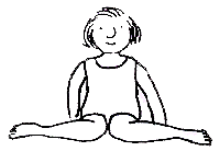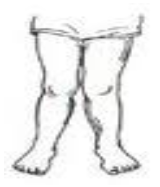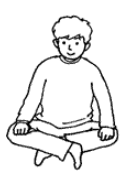W-Sitting
Encouraging your child to assume more developmentally appropriate positions during play
 I see W-sitting everywhere – in my daughter’s play group, at the park and even on TV commercials. As a PT I often get questions from parents asking, “Is W-sitting really a problem?” or “My child seems most comfortable when W-sitting. Should I really ask him to sit differently?” The answer to both is yes! W-sitting is a problem that can have long term effects on your child’s bony alignment, muscle length and muscle strength, which can contribute to challenges what walking, running and higher-level gross motor skills.
I see W-sitting everywhere – in my daughter’s play group, at the park and even on TV commercials. As a PT I often get questions from parents asking, “Is W-sitting really a problem?” or “My child seems most comfortable when W-sitting. Should I really ask him to sit differently?” The answer to both is yes! W-sitting is a problem that can have long term effects on your child’s bony alignment, muscle length and muscle strength, which can contribute to challenges what walking, running and higher-level gross motor skills.
W-sitting is where a child sits with their bottom on the ground and knees bent to the side with their feet either facing inwards or outwards. It’s also known as reverse cross-legged sitting. Children, both with and without neuromotor diagnoses, will choose to W-sit for a variety of reasons. First, this position gives the child a very wide base of support, which makes their trunk muscles have to work less. Second, children who have tight muscles in their legs may choose to sit this way because they will not feel a stretch on these muscles. Third, W-sitting limits the amount of work the abdominal muscles and muscles on the outer thigh have to do when transitioning into and out of sitting, which are muscles that are typically underused and weaker than the muscles of the low back and inner thigh.
There are several reasons that we want our children to utilize positions other than W-sitting, but overall it is because we want our children to have many, many repetitions into and out of positions that will assist in their gross motor development. When a young child W-sits, their base is very wide, making it difficult to transition out of sitting to crawling or standing. When a child who does not W-sit is in this stage, they will have hundreds of repetitions a day going from sitting to crawling or standing and back to sit again by  transitioning on a diagonal over their hip. Each transition strengthens the child’s abdominal and outer hip muscles.1 A second reason to avoid W-sitting is because it encourages a position of excessive medial femoral torsion, which is when your thigh is turned inwards.1 In a full-term infant, medial femoral torsion is about 40 degrees.1 In an adult, that number reduces to about 16 degrees.1 As a child moves and transitions in play,the forces applied to the bone by the muscles affects the bony development. If a child continually utilizes positions where their thigh bone is turned inwards, they may never reduce the medial femoral torsion.2 When medial femoral torsion is retained, the child’s legs will looked turned inwards when standing and their knees may touch. Long term, this could contribute to knee or hip pain.
transitioning on a diagonal over their hip. Each transition strengthens the child’s abdominal and outer hip muscles.1 A second reason to avoid W-sitting is because it encourages a position of excessive medial femoral torsion, which is when your thigh is turned inwards.1 In a full-term infant, medial femoral torsion is about 40 degrees.1 In an adult, that number reduces to about 16 degrees.1 As a child moves and transitions in play,the forces applied to the bone by the muscles affects the bony development. If a child continually utilizes positions where their thigh bone is turned inwards, they may never reduce the medial femoral torsion.2 When medial femoral torsion is retained, the child’s legs will looked turned inwards when standing and their knees may touch. Long term, this could contribute to knee or hip pain.
There are ways to give our kids comfortable, developmentally appropriate sitting options. This can be a difficult task, especially for those children who have been W-sitting for quite a while.
 Alternatives sitting positions include:
Alternatives sitting positions include:
- Cross-legged sitting
- Sitting with legs straight out in front with back straight
- Bench sitting with feet supported
When working to change your child’s preferred sitting position, the initial goal should be to reduce W-sitting by 10% during the day. Then increase to 25%, 50%, etc. When you catch your child W-sitting, choose a phrase that you will consistently use to ask them to switch positions. For example, with my daughter I always say, “Maggie, change your sitting position.” After a few days, she learned what this meant and then would immediately switch to cross-leg sitting. The more repetitions that your child has in alternate sitting positions, the more likely they will be to choose those sitting positions independently.
- Cusick, B. Is W-Sitting a Problem? Managing the Modeling of Bone and Joint Geometry. Therapy Skill Builders. 1999: 37-43.
- Campbell, S, Palisano, R, Orlin, M. Musculoskeletal Development And Adaptation. Physical Therapy for Children. 4th ed. St. Louis, MO: Elsevier Saunders; 2012:186.

